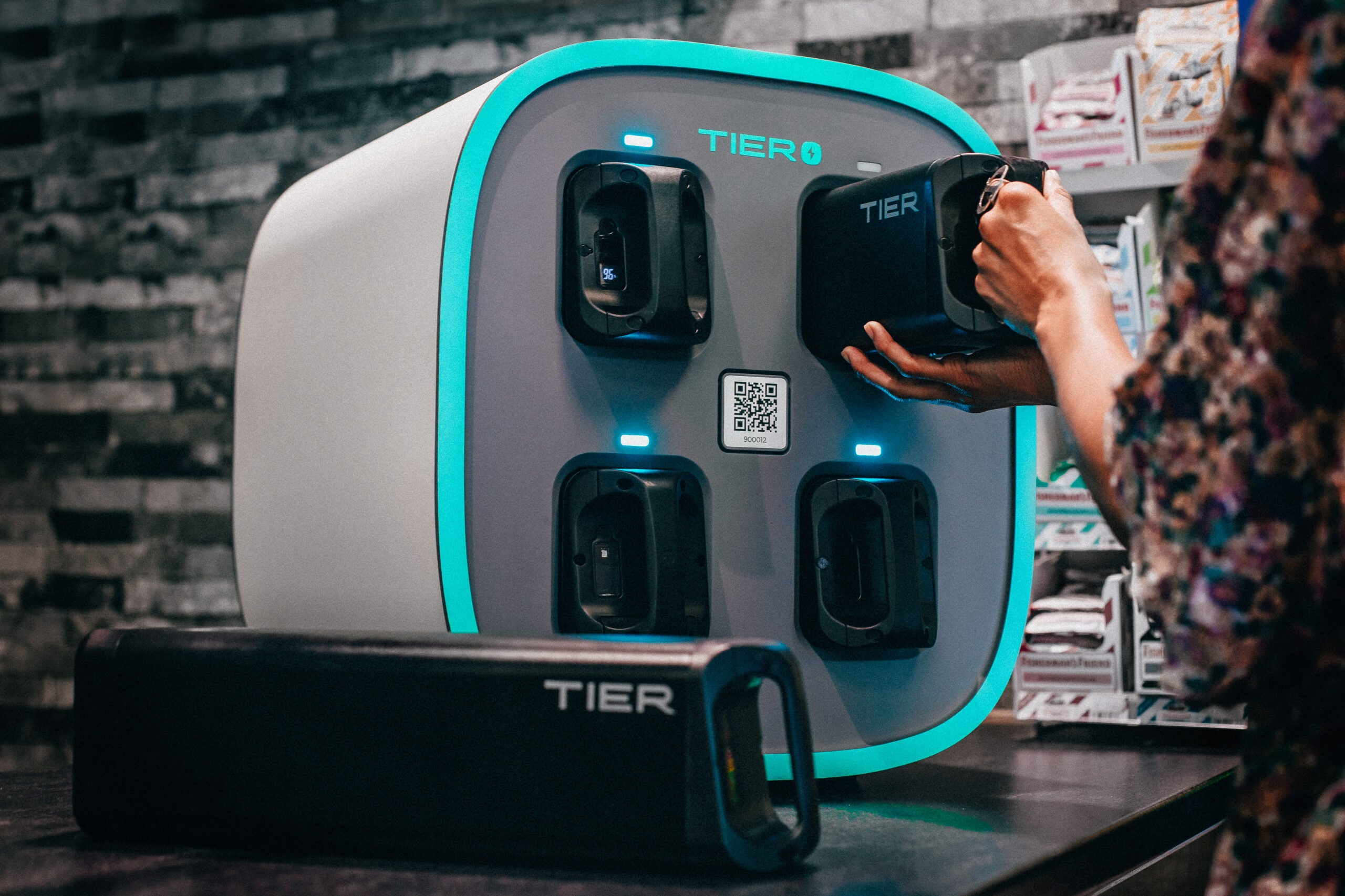
Electric scooters are wildly popular but rental companies struggle with profitability. Yet fierce competition in a narrowly defined business model has sparked creative innovations aimed at improving the bottom line.
Tier Mobility, which has moved to a swappable battery model for its e-scooter fleet, is one such example. The Berlin-based startup has created a charging station, to be located in partner stores, which riders can use to swap depleted batteries for charged ones in exchange for a free ride.
The charging station plugs into the mains and can charge four batteries at once at 700 kilowatt-hours, taking around two and a half hours to fully recharge.
“The really nice thing is you can just plug it in at the store into the wall,” said Lawrence Leuschner, co-founder and CEO of Tier Mobility, speaking at a launch event in London. “There is no extra cabling, there’s no extra infrastructure… so it’s very convenient. It’s not very costly for us. So we can actually deploy a charging network across the city.”
The idea has been well received among local governments, said Leuschner, which often have limited budgets to invest in the large infrastructure projects needed to make the switch to electric transport. But in this case, Tier takes on the infrastructure cost with the doubled benefit of reducing its own labour costs from not sending staff to switch dead batteries. Meanwhile, stores are incentivised to host the charging station because of the extra customers it brings in.
“The store has the advantage that they get additional footfall into the store,” explained Leuschner. “People are coming actively into the store, swapping the battery and then they probably want to buy something else. So the store has a huge advantage of getting extra customers. The city loves it because we’ve created an environment of infrastructure without the investments and for us it’s great because we are reducing our costs.”
How well do you really know your competitors?
Access the most comprehensive Company Profiles on the market, powered by GlobalData. Save hours of research. Gain competitive edge.

Thank you!
Your download email will arrive shortly
Not ready to buy yet? Download a free sample
We are confident about the unique quality of our Company Profiles. However, we want you to make the most beneficial decision for your business, so we offer a free sample that you can download by submitting the below form
By GlobalDataDuring the London launch event, Leuschner demonstrated the battery changing process. When unlocking the e-scooter using the Tier app, the rider is given the option to switch the battery at a nearby partner store. Once there, the store employee scans a QR code on the rider’s app, which releases a charged battery. In all, the process took around 30 seconds.
In January, Tier acquired UK startup Pushme, the company that developed the replaceable battery bank for Tier. If the move to users replacing batteries catches on, it could prove to be a shrewd investment.
Tier e-scooter battery: A boost to profits?
So why could this approach be such a boost to profits? It all comes down to unit economics. An e-scooter needs to carry out a minimum number of rides to recoup the cost of purchasing it before it can make a profit. That’s before factoring in the costs of marketing, licencing, insurance, maintenance – and labour costs for switching the batteries.
Lime and Bird have taken the approach of hiring gig economy workers to load scooters into vans to be taken away for charging overnight. This model – like many other forms of gig economy work – has come under fire for its precariousness and low pay, which ranges between $3 to $20 per scooter. It can also reduce the lifespan of e-scooters as they are more likely to pick up knocks being shipped to a charging warehouse by van each day.
 Second mover advantage has seen Tier, along with rivals Wind, Voi and Dott, learn from early drawbacks and switch to removable batteries, as well as modular designs that allow repairs to be carried out in the field.
Second mover advantage has seen Tier, along with rivals Wind, Voi and Dott, learn from early drawbacks and switch to removable batteries, as well as modular designs that allow repairs to be carried out in the field.
For Tier, which is active in some 70 cities, the switch to swappable batteries already seems to paying off. Since June, the startup said it has been profitable before taxes, depreciation and amortisation.
While charging docking stations are another solution that can cut labour costs for recharging e-scooters, these require a much larger infrastructure investment and limit where riders can take the vehicles. Having users replace batteries themselves is also keeping closer to the true spirit of the so-called sharing economy, from which the idea for rental e-scooters first originated.
While Tier’s approach to e-scooter batteries makes complete sense in theory, it remains unclear as of yet how successful it will be in practice.
Some batteries may be dropped and damaged by riders, other users may be put off by the idea of having to swap the battery themselves. Some stores may not like the idea of keeping a chunky charging station behind the till, or they may not feel the cost from the extra footfall is worth the space and electricity costs. And to create a truly electrified network, Tier needs buy-in from stores right across the city.
Read more: Tier Mobility makes UK e-scooter push as trials poised to start




